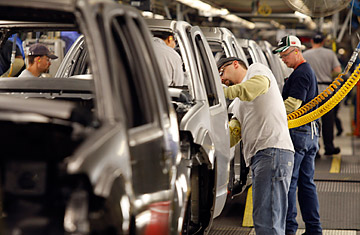
Nissan employees work on Xterra vehicles at the company's plant in Smyrna, Tenn.
The Obama Administration has approved fuel-economy regulations, beginning with 2012-model-year vehicles. The rules require automakers to improve fleetwide fuel economy and to reduce fleetwide greenhouse-gas emissions by approximately 5% every year up until the 2016 model year. On fuel economy, manufacturers must achieve a combined average vehicle-emission level of 250 grams of carbon dioxide per mile, which equates to fuel efficiency of 35.5 miles per gallon.
The targets are aggressive, but they may not be as difficult to meet as you might think. All the automakers have agreed to the rules because they think they can use new but existing technology to meet the standards. Here are the key ways that carmakers believe they can achieve the new targets:
Aerodynamic Styling
Reducing friction or aerodynamic drive has become a major goal of automotive designers. The front of the vehicle, wheel wells and underbody, where the industry's cost-conscious executives were loath to spend money in the past, are being redesigned to produce substantial reductions of 5% to 10% in aerodynamic drag. The energy savings can be significant. A 10% reduction in drag increases fuel economy by approximately 1% for cars and approximately 2% for trucks with conventional internal-combustion engines, according to the Ford Motor Co. In the 2010 model year, Ford introduced modifications to the Ford Fusion and Lincoln models to make them 5% more aerodynamic, producing a half-mile-per-gallon improvement in fuel economy.
Cool Paint
Cool paint, as its name implies, helps keep the car's interior from overheating if it's left in the sun. Technically speaking, cool paint, which is based on nanotechnology, reduces the thermal load on the car, which means the air-conditioning doesn't have to work as hard or as long, providing a small but noticeable boost to fuel economy of roughly 1% to 2%.
Eight-Speed Transmissions
More gears means better fuel economy. The use of eight-speed transmissions, which began showing up in cars like the BMW 760i for the first time last year, can provide an additional 15% improvement in fuel economy. The transmission boosts fuel economy by improving the overall efficiency and reducing the frictional losses, which waste energy.
Direct Injection
Putting the fuel directly into the combustion chamber can improve fuel consumption by between 1.5% and 3%. Internal-combustion engines are inherently wasteful because not all the fuel is burned and converted into energy, as Charles Kettering, the first head of GM's scientific laboratories, observed more than 90 years go. Direct injection increases the amount of fuel that is actually burned.
Electric Power Steering
Electric Power Steering (EPS) uses less energy than the mechanical steering system, which relies on pumps and hydraulics. An EPS system can improve fuel economy by about 4%. Ford Motor Co. has been a big proponent of EPS, having installed it in the 2010 Ford Fusion, Mercury Milan, Ford Taurus SHO and Lincoln MKT. The new EPS systems are small, lighter and typically quieter than the older units, making them more adaptable to today's vehicles. The systems cost about $200 more than conventional steering systems.
Low-Rolling-Resistance Tires
Carmakers and tiremakers have been experimenting with low-rolling resistance tires, which lose less heat energy as they roll down the road, ever since General Motors brought out its EV1 electrical vehicle in the early 1990s. Among the challenges are tread design, which has an impact on performance on icy or wet surfaces and tire durability. The payoff though is substantial — better tires can improve fuel economy by roughly 2%, according to a study done for the National Academy of Sciences. The technological breakthrough that is making these tires a reality is a relatively new polymer material that allows the tire to retain its basic shape as it rolls under weight down the road.
Variable-Stroke HVAC
Heating and cooling today's automobiles absorbs substantial energy. Modernizing the heating, ventilation and air-conditioning (HVAC) system with the latest technology can help improve fuel economy by 3% to 4%. The new systems feature re-engineered components such as fans and compressors and are sealed better to keep energy from seeping away.
Overall, the changes will make vehicles more expensive, ranging from an extra $10 per tire to almost $700 per vehicle for the eight-speed transmission. The Environmental Protection Agency estimates the cost of all these technical improvements at $985 per vehicle. But the expected improvements in fuel economy are considerable and could save drivers roughly $4,000 over the life of the car. Beyond 2016, carmakers are looking at total vehicle redesigns and material substitutions that would reduce vehicle mass considerably, making even cars powered by the old-fashioned internal combustion far more efficient.
